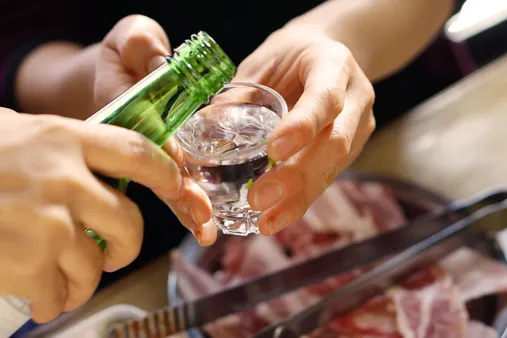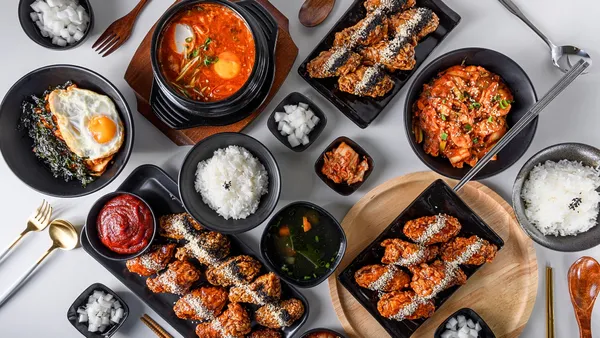Table of Contents
Embark on a culinary journey through The etiquette and customs of Korean dining with Tauhuichiban. Understanding these cultural nuances will elevate your dining experience, ensuring you navigate this rich tradition with respect and appreciation. From the significance of specific dishes to the intricacies of table manners, this comprehensive guide will provide you with the knowledge and confidence to fully immerse yourself in the vibrant world of Korean cuisine.

The Etiquette and Customs of Korean Dining: A Comprehensive Guide to Korean Table Manners
I. Etiquette When Dining with Koreans
When dining with Koreans, it is important to be mindful of the following etiquette rules:
- Be punctual. Koreans value punctuality, so it is important to arrive on time for your meal.
- Remove your shoes before entering the dining room. This is a sign of respect for the host and the home.
- Sit in the seat that is assigned to you. The host will usually indicate where you should sit.
- Wait for the host to start eating before you begin. It is considered rude to start eating before the host.
- Use chopsticks and a spoon to eat. Chopsticks are used to pick up food, while the spoon is used to eat soup and rice.
- Do not stick your chopsticks into your rice. This is considered to be disrespectful.
- Do not leave your chopsticks in your bowl when you are not eating. This is considered to be rude.
- Do not blow your nose at the table. This is considered to be rude.
- Do not talk loudly or make a lot of noise while eating. This is considered to be disrespectful.
- Do not leave the table before the host. It is considered rude to leave the table before the host has finished eating.
By following these etiquette rules, you can show your respect for Korean culture and ensure that you have a pleasant dining experience.
Korean Dining Etiquette | Description |
|---|---|
Be punctual | Koreans value punctuality, so it is important to arrive on time for your meal. |
Remove your shoes before entering the dining room | This is a sign of respect for the host and the home. |
Sit in the seat that is assigned to you | The host will usually indicate where you should sit. |
Wait for the host to start eating before you begin | It is considered rude to start eating before the host. |
Use chopsticks and a spoon to eat | Chopsticks are used to pick up food, while the spoon is used to eat soup and rice. |
By following these etiquette rules, you can show your respect for Korean culture and ensure that you have a pleasant dining experience.
In addition to the etiquette rules listed above, there are a few other things to keep in mind when dining with Koreans:
- It is considered polite to bring a small gift for the host. This could be something like a box of chocolates or a bottle of wine.
- It is also considered polite to offer to help with the dishes after the meal.
- If you are invited to a Korean home for dinner, it is important to dress respectfully. This means avoiding shorts, tank tops, and other casual clothing.
By following these tips, you can ensure that you have a positive and enjoyable dining experience with Koreans.
Here are some additional tips for dining with Koreans:
- Be prepared to eat a lot of food. Korean meals are typically large and consist of many different dishes.
- Do not be afraid to try new things. Korean food is very diverse, so there is sure to be something that you will enjoy.
- Have fun! Dining with Koreans is a great way to learn about Korean culture and make new friends.
I hope this information has been helpful. Please let me know if you have any other questions.
Sincerely,
Your Korean Dining Etiquette Guide

Etiquette When Dining with Koreans
II. Korean Dining Customs: A Guide to Korean Dining Etiquette
Korean dining etiquette is a set of rules and customs that govern the behavior of diners at a Korean meal. These rules are designed to ensure that everyone has a pleasant and enjoyable dining experience. Some of the most important Korean dining customs include:
- Respect for elders. Elders are highly respected in Korean culture, and this respect extends to the dining table. Younger diners should always serve food to older diners first, and they should not begin eating until the elders have started.
- Communal dining. Korean meals are typically served family-style, with all of the dishes placed in the center of the table. Diners share the food from the communal dishes, using their own chopsticks and spoons.
- Noisy eating. It is considered rude to make noise while eating in Korea. This includes slurping, chewing loudly, or talking with your mouth full.
- Finishing your food. It is considered impolite to leave food on your plate in Korea. If you cannot finish your food, you should ask for a doggy bag to take it home.
By following these simple rules, you can ensure that you have a pleasant and enjoyable dining experience when you eat Korean food.
Korean Dining Custom | Description |
|---|---|
Respect for elders | Elders are highly respected in Korean culture, and this respect extends to the dining table. Younger diners should always serve food to older diners first, and they should not begin eating until the elders have started. |
Communal dining | Korean meals are typically served family-style, with all of the dishes placed in the center of the table. Diners share the food from the communal dishes, using their own chopsticks and spoons. |
Noisy eating | It is considered rude to make noise while eating in Korea. This includes slurping, chewing loudly, or talking with your mouth full. |
Finishing your food | It is considered impolite to leave food on your plate in Korea. If you cannot finish your food, you should ask for a doggy bag to take it home. |
In addition to the general rules of Korean dining etiquette, there are also some specific customs that apply to certain dishes. For example, when eating rice, it is considered polite to hold your bowl with one hand and use your chopsticks to scoop the rice into your mouth. When eating soup, it is considered polite to use a spoon to scoop the soup into your mouth, and not to drink it directly from the bowl.
By following these simple rules, you can ensure that you have a pleasant and enjoyable dining experience when you eat Korean food.
Here are some additional tips for dining in Korea:
- Be on time. Punctuality is important in Korean culture, so it is important to be on time for your meal. If you are running late, be sure to call or text the host to let them know.
- Dress appropriately. Koreans typically dress modestly, so it is important to dress appropriately for your meal. Avoid wearing shorts, tank tops, or other revealing clothing.
- Be respectful of your host. Your host will go to great lengths to make sure that you have a pleasant dining experience. Be sure to show your appreciation by being respectful and following their lead.
By following these tips, you can ensure that you have a positive and enjoyable dining experience when you eat Korean food.
Here are some additional resources that you may find helpful:

Korean Dining Customs: A Guide to Korean Dining Etiquette
III. Unique Table Manners and Customs in Korean Dining
Korean dining etiquette is a fascinating blend of tradition and modernity. Understanding these customs will enhance your dining experience and show respect for Korean culture.
One of the most important aspects of Korean table manners is the use of chopsticks. Chopsticks are held in the right hand, with the thumb and index finger holding the top chopstick and the middle finger supporting the bottom chopstick. Never stick your chopsticks vertically into your rice, as this is considered disrespectful. When not in use, chopsticks should be placed on the table or in a chopstick rest.
Another important custom is the sharing of food. Koreans often share dishes with each other, so it is considered polite to offer a portion of your food to others at the table. It is also considered polite to finish everything on your plate, as leaving food behind is seen as wasteful.
When dining with Koreans, it is important to be respectful of the elders at the table. Elders are typically served first, and it is considered polite to wait until they have started eating before you begin. It is also important to avoid talking loudly or interrupting others while they are eating.
These are just a few of the many table manners and customs that are observed in Korean dining. By following these customs, you can show respect for Korean culture and ensure that you have a positive dining experience.
Korean Table Manners | Description |
|---|---|
Use chopsticks correctly | Hold chopsticks in the right hand, with the thumb and index finger holding the top chopstick and the middle finger supporting the bottom chopstick. |
Share food | Koreans often share dishes with each other, so it is considered polite to offer a portion of your food to others at the table. |
Finish everything on your plate | Leaving food behind is seen as wasteful. |
Be respectful of elders | Elders are typically served first, and it is considered polite to wait until they have started eating before you begin. |
Avoid talking loudly or interrupting others | It is considered rude to talk loudly or interrupt others while they are eating. |

Unique Table Manners and Customs in Korean Dining
IV. Korean Dining Taboos to Avoid
Chopsticks Etiquette
- Never stick your chopsticks vertically into your rice. This is associated with death and funerals.
- Do not use your chopsticks to point at someone or something.
- Do not leave your chopsticks unattended in your bowl.
- Do not use your chopsticks to stir your food.
- Do not use your chopsticks to eat directly from a communal dish.
Table Manners
- Always wait for the eldest person at the table to start eating.
- Do not slurp your food.
- Do not talk with your mouth full.
- Do not blow your nose at the table.
- Do not burp or fart at the table.

Korean Dining Taboos to Avoid
V. Conclusion
Korean dining etiquette is a reflection of the country's deep cultural values, emphasizing respect, harmony, and communal enjoyment. By observing these customs, you not only enhance your dining experience but also demonstrate your appreciation for Korean culture. Embrace the traditions of Korean dining with an open heart and a willingness to learn. Your efforts will be rewarded with memorable meals and a deeper connection to the Korean way of life. Immerse yourself in the rich tapestry of Korean dining etiquette and create unforgettable culinary experiences.